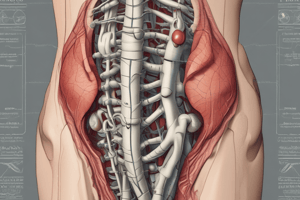Podcast
Questions and Answers
What movement does the pelvis perform when it rotates about a vertical axis?
What movement does the pelvis perform when it rotates about a vertical axis?
- Lateral tilt
- Anterior tilt
- Right & Left rotation (correct)
- Pelvic shift
What is the effect of a posterior pelvic tilt?
What is the effect of a posterior pelvic tilt?
- Increased lumbar lordosis and decreased hip extension
- No change in lumbar lordosis and hip position
- Decreased lumbar lordosis and increased hip extension (correct)
- Increased lumbar lordosis and hip flexion
What happens to the pelvis during right and left lateral tilt?
What happens to the pelvis during right and left lateral tilt?
- The pelvis tilts forward or backward
- The pelvis shifts laterally with no rotation
- The pelvis remains stable without movement
- The pelvis tilts laterally about the sagittal axis (correct)
What muscle shortening is associated with increased anterior pelvic tilt?
What muscle shortening is associated with increased anterior pelvic tilt?
Which of the following describes right and left pelvic shift?
Which of the following describes right and left pelvic shift?
What happens to the base of support when only the lower extremity is used?
What happens to the base of support when only the lower extremity is used?
What effect does a lateral pelvic shift to the right have on the body's center of mass?
What effect does a lateral pelvic shift to the right have on the body's center of mass?
What occurs simultaneously when a lateral pelvic shift to the right is performed?
What occurs simultaneously when a lateral pelvic shift to the right is performed?
Which side of the pelvis is unsupported when performing a lateral pelvic shift to the right?
Which side of the pelvis is unsupported when performing a lateral pelvic shift to the right?
What identifies the direction of pelvic rotation?
What identifies the direction of pelvic rotation?
What is the consequence of having only the right foot as the base of support?
What is the consequence of having only the right foot as the base of support?
During right pelvic rotation, which side of the pelvis is anterior to the other?
During right pelvic rotation, which side of the pelvis is anterior to the other?
What occurs when the left lower extremity is the weight-bearing extremity?
What occurs when the left lower extremity is the weight-bearing extremity?
What is lateral pelvic shift characterized by?
What is lateral pelvic shift characterized by?
What movement works in conjunction with lateral pelvic shift?
What movement works in conjunction with lateral pelvic shift?
What characterizes lateral pelvic tilt?
What characterizes lateral pelvic tilt?
Which hip movement occurs on the stance leg during lateral pelvic tilt?
Which hip movement occurs on the stance leg during lateral pelvic tilt?
What causes pelvic elevation?
What causes pelvic elevation?
What is the term for the movement where one side of the pelvis is higher than the other?
What is the term for the movement where one side of the pelvis is higher than the other?
Which muscle pair contributes to left pelvic elevation?
Which muscle pair contributes to left pelvic elevation?
Flashcards are hidden until you start studying
Study Notes
Movements of the Pelvis
- Right & Left Rotation: Rotates about a vertical axis.
- Right & Left Lateral Tilt: Tilts laterally around the sagittal axis.
- Right & Left Anterior/Posterior Tilt: Tilts about the frontal axis, affecting trunk and hip positions.
- Right & Left Pelvic Shift: Lateral movement in the frontal plane without an axis of rotation.
Pelvic Tilts
- Anterior Pelvic Tilt: As the anterior superior iliac spines (ASIS) move forward of the pubic symphysis, increased lumbar lordosis and hip flexion occur.
- Posterior Pelvic Tilt: ASIS shift backward relative to the pubic symphysis, resulting in decreased lumbar lordosis and increased hip extension.
Muscles and their Effect on Pelvic Tilts
- Shortened hip flexors: Lead to increased anterior pelvic tilt and enhanced lumbar lordosis.
- Shortened hamstrings: Contribute to increased posterior pelvic tilt and reduced lumbar lordosis.
Lateral Pelvic Tilt
- Exists when iliac crests are uneven; lateral movement causes one side to elevate and the other to lower.
- Direction of tilt is determined by the lower side of the pelvis; commonly results from hip abductor weakness during single-leg stance.
- Osteokinematic Movements:
- Adduction of the stance leg (higher side).
- Abduction of the unsupported leg (lower side).
- Example: Standing on right leg without right hip abductors leads to left lateral pelvic tilt, where the left pelvis drops.
Pelvic Elevation
- Defined as one side of the pelvis being higher, resulting from concentric contractions.
- Often referred to as hip hiking.
- Force Couple: Involves the left quadratus lumborum and right hip abductors.
- Osteokinematic Movements:
- Adduction of the elevated hip (higher side).
- Abduction of the stance hip (lower side).
Pelvic Rotation
- Occurs when one side of the pelvis moves forward or backward relative to the other.
- Direction is identified by the forward side of the pelvis.
- Right Pelvic Rotation: Right side moves anteriorly, often occurring with left hip medial rotation and left leg as the weight-bearer.
- Left Pelvic Rotation: Left side anteriorly rotates with the left leg as the weight-bearer, producing left hip lateral rotation.
Lateral Pelvic Shift
- A side-to-side linear movement accompanying lateral pelvic tilt, essential for balancing the center of mass over a single-leg base of support.
- Example: In right single-leg stance, a lateral shift right aligns the center of mass over the right foot, with a concurrent left lateral pelvic tilt due to the left side being unsupported.
Studying That Suits You
Use AI to generate personalized quizzes and flashcards to suit your learning preferences.




